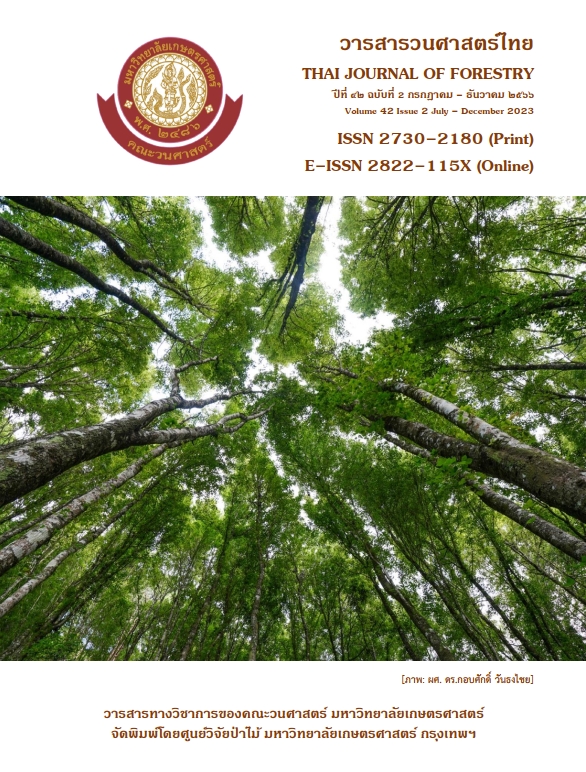สังคมกล้าไม้ของป่าเบญจพรรณและป่าเต็งรัง ภายใต้การรุกรานของต้นสาบเสือ (Chromolaena odorata) ในวนอุทยานน้ำตกตาดสายรุ้ง จังหวัดเชียงราย
Main Article Content
บทคัดย่อ
การศึกษาในครั้งนี้มีวัตถุประสงค์เพื่อศึกษาสังคมกล้าไม้ของป่าเบญจพรรณและป่าเต็งรัง ภายใต้การรุกรานของต้นสาบเสือในพื้นที่วนอุทยานน้ำตกตาดสายรุ้ง จังหวัดเชียงราย ดำเนินการวางแปลงตัวอย่างชั่วคราว ขนาด 1 เมตร x 1 เมตร จำนวน 60 แปลง โดยใช้การสุ่มตัวอย่างแบบมีระบบ พบว่า พื้นที่ป่าเบญจพรรณและป่าเต็งรังที่มีต้นสาบเสือรุกราน มีองค์ประกอบของกล้าไม้จำนวน 24 ชนิด 23 สกุล 16 วงศ์ และ 4 ชนิด 4 สกุล 2 วงศ์ ตามลำดับ มีความหนาแน่นของกล้าไม้รวม 16,538 และ 5,000 ต้นต่อเฮกตาร์ ตามลำดับ ในพื้นที่ที่ไม่พบการรุกรานของต้นสาบเสือ ป่าเบญจพรรณและป่าเต็งรัง มีองค์ประกอบของกล้าไม้ จำนวน 17 ชนิด 16 สกุล 13 วงศ์ และ 8 ชนิด 7 สกุล 6 วงศ์ ตามลำดับ ความหนาแน่นของกล้าไม้ มีค่าเท่ากับ 12,884 และ 10,576 ต้นต่อเฮกตาร์ ตามลำดับ เมื่อเปรียบเทียบปริมาณมวลชีวภาพในสังคมพืชสาบเสือ พบว่า ต้นสาบเสือมีปริมาณสูงที่สุด รองลงมา คือ ไม้พื้นล่าง และกล้าไม้ ตามลำดับ ในทางกลับกันมวลชีวภาพกล้าไม้ของสังคมพืชป่าเบญจพรรณที่ไม่มีต้นสาบเสือรุกราน พบว่าปริมาณมวลชีวภาพกล้าไม้มีค่าสูงกว่า ซึ่งแตกต่างจากในสังคมพืชป่าเต็งรัง ขณะที่ปริมาณมวลชีวภาพกลุ่มไม้พื้นล่างนั้นมีค่าต่ำกว่าสังคมพืชสาบเสือในทั้งสองชนิดป่า การรุกรานของต้นสาบเสือมีผลต่อต้นเต็ง (Shorea obtusa) รัง (Shorea siamensis) มะห้า (Syzygium oblatum) และก่อเดือย (Castanopsis acuminatissima) เนื่องจากกล้าไม้มีการกระจายและมีความหนาแน่นมากเฉพาะพื้นที่ที่ไม่มีต้นสาบเสือ ดังนั้น การจัดการอย่างยั่งยืนควรพิจารณาปลูกกล้าไม้เสริมโครงสร้างป่าด้วยวิธีพรรณไม้โครงสร้างโดยพิจารณาปลูกเสริมจากค่าดัชนีความสำคัญของพันธุ์พืช รวมถึงศึกษาชนิดไม้ที่ทนทานต่อการรุกรานของพืชต่างถิ่นรุกราน ที่จะช่วยเพิ่มปริมาณกล้าไม้ดั้งเดิมที่เหมาะสม เพื่อรักษาระบบนิเวศสังคมพืชป่าชนิดนั้นๆ ตลอดจนการสร้างความตระหนักและเผยแพร่ความรู้เกี่ยวกับผลกระทบของชนิดพันธุ์ต่างถิ่นรุกรานผู้เข้าใช้พื้นที่ต่อไป
Downloads
Article Details

อนุญาตภายใต้เงื่อนไข Creative Commons Attribution-NonCommercial-NoDerivatives 4.0 International License.
ข้าพเจ้าและผู้เขียนร่วม (ถ้ามี) ขอรับรองว่า ต้นฉบับที่เสนอมานี้ยังไม่เคยได้รับการตีพิมพ์และไม่ได้อยู่ในระหว่างกระบวนการพิจารณาตีพิมพ์ลงในวารสารหรือสิ่งตีพิมพ์อื่นใด ข้าพเจ้าและผู้เขียนร่วม (ถ้ามี) ยอมรับหลักเกณฑ์และเงื่อนไขการพิจารณาต้นฉบับ ทั้งยินยอมให้กองบรรณาธิการมีสิทธิ์พิจารณาและตรวจแก้ต้นฉบับได้ตามที่เห็นสมควร พร้อมนี้ขอมอบลิขสิทธิ์ผลงานที่ได้รับการตีพิมพ์ให้แก่วารสารวนศาสตร์ คณะวนศาสตร์ มหาวิทยาลัยเกษตรศาสตร์ กรณีมีการฟ้องร้องเรื่องการละเมิดลิขสิทธิ์เกี่ยวกับภาพ กราฟ ข้อความส่วนใดส่วนหนึ่ง หรือ ข้อคิดเห็นที่ปรากฏในผลงาน ให้เป็นความรับผิดชอบของข้าพเจ้าและผู้เขียนร่วม (ถ้ามี) แต่เพียงฝ่ายเดียว และหากข้าพเจ้าและผู้เขียนร่วม (ถ้ามี) ประสงค์ถอนบทความในระหว่างกระบวนการพิจารณาของทางวารสาร ข้าพเจ้าและผู้เขียนร่วม (ถ้ามี) ยินดีรับผิดชอบค่าใช้จ่ายทั้งหมดที่เกิดขึ้นในกระบวนการพิจารณาบทความนั้น”
เอกสารอ้างอิง
Charungphan, K., Muangsri, B., Kongcheepyueun, N., Rangmak, T., Kongcheepyuen, S. 2015. Species and distribution of invasive alien plants in the national park. In Proceedings of the 5th Conference of the Thailand Forest Ecology Research Network. Bankok, Thailand, pp. 170–176. (in Thai)
Chen, J., Ma, F., Zhang, Y., Wang, C., Xu, H. 2021. Spatial distribution patterns of invasive alien species in China. Global Ecology and Conservation, 26 (e01432). doi: 10.1016/j.gecco.2020.e01432.
Gautier, L. 1992. Taxonomy and distribution of a tropical weed: Chromolaena odorata (L.) R. King & H. Robinson. Candollea, 47(2): 645-662.
Hamidi, F.W.A., Ismail, A.M., Zainuddin, F.H.I., Hasan, M.Y. 2014. Preliminary study on allelopathic effect from Chromolaena odarata (siam weed) leaves extract towards Vigna radiata. International Journal of Engineering Research & Technology, 3 :406-411.
Kutintara, U. 1999. Fundamental of Forest Ecology. Faculty of Forestry, Kasetsart University, Bangkok, Thailand. (in Thai)
Lowe, S., Browne, M., Boudjelas, S. 2004. 100 of the World's Worst Invasive Alien Species. Hollands Printing Ltd., The Invasive Species Specialist Group, The International Union for Conservation of Nature, New Zealand.
Napompeth, B., Winotai, A., Muniappan, R., Ferrar, P. 1991. Progress on biological control of Siam weed, Chromolaena odorata in Thailand. BIOTROP Special Publication, 44: 91-97.
Ngamchareon, C. 2005. Management of Invasive Alien Plants in the National Park. Department of National Parks, Wildlife and Plant Conservation. Bangkok, Thailand. (in Thai)
Office of Natural Resources and Environmental Policy and Planning. 2018. Cabinet Resolution on February 20, 2018 on Measures to Prevent, Control and Eradicate Invasive Species. Ministry of Natural Resources and Environment, Bangkok, Thailand. (in Thai)
Rakarcha, S., Saensouk, S., Saensouk, P. 2020. Species Diversity of Understory Plant in Khok Nong Khwang Forest, Kantharawichai District, Maha Sarakham Province. KKU Science Journal, 48(3): 364-376. (in Thai)
Shimwell, D.W. 1971. The Description and Classification of Vegetation. Sidgwick and Jackson. London, England.
Sirimakron, R. 2009. The Effects of Prescribed Burning on Habitat Use of Large Herbivores in Huai Kha Khaeng Wildlife Sanctuary, Uthai Thani Province. M.S. Thesis, Kasetsart University. Bangkok, Thailand. (in Thai)
Tarachai, Y., Hemsant, A., Chanrat, P., Patiphanthakan, P. 2020. Distribution of invasive plants in Bann Pong Conservation Forest Area, Sansai district, Chiang Mai province. Journal of Research Unit on Science, Technology and Environment for Learning, 11(1): 1-15.
Thapa, L.B., Kaewchumnong, K., Sinkkonen, A., Sridith, K. 2016. Impacts of invasive Chromolaena odorata on species richness, composition and seedling recruitment of Shorea robusta in a tropical Sal Forest, Nepal. Songklanakarin Journal of Science & Technology, 38(6): 683-689.
The Forest Restoration Research Unit. 2006. How to Plant a Forest: The Principles and Practice of Restoring Tropical Forests. Biology Department, Science Faculty, Chiang Mai University. Chiang Mai, Thailand. (in Thai)
Uyi, O., Igbinosa, I. B. 2010. The status of Chromolaena odorata and its biocontrol in West Africa. In: Proceedings of the 8th International Workshop on Biological Control and Management of Chromolaena odorata and other Eupatorieae. Nairobi, Kenya, pp. 1-2.


